Leadership, Management, and Strategies at John Lewis Partnership Plc
VerifiedAdded on 2020/12/09
|8
|2426
|237
Report
AI Summary
This report provides a detailed analysis of John Lewis Partnership Plc, a major UK retail company. It explores the company's history, vision, leadership style (specifically democratic and participative), management practices (including administrative management theory), and strategies (differentiation, investment maintenance, and employee focus). The report examines how these elements are implemented within the organization, with a focus on employee engagement and decision-making. It offers recommendations for improvement, such as balancing participative approaches with necessary discipline and enhancing customer satisfaction through surveys. The report concludes that effective leadership, management, and strategic planning are essential for organizational success.

Individual Report
Paraphrase This Document
Need a fresh take? Get an instant paraphrase of this document with our AI Paraphraser
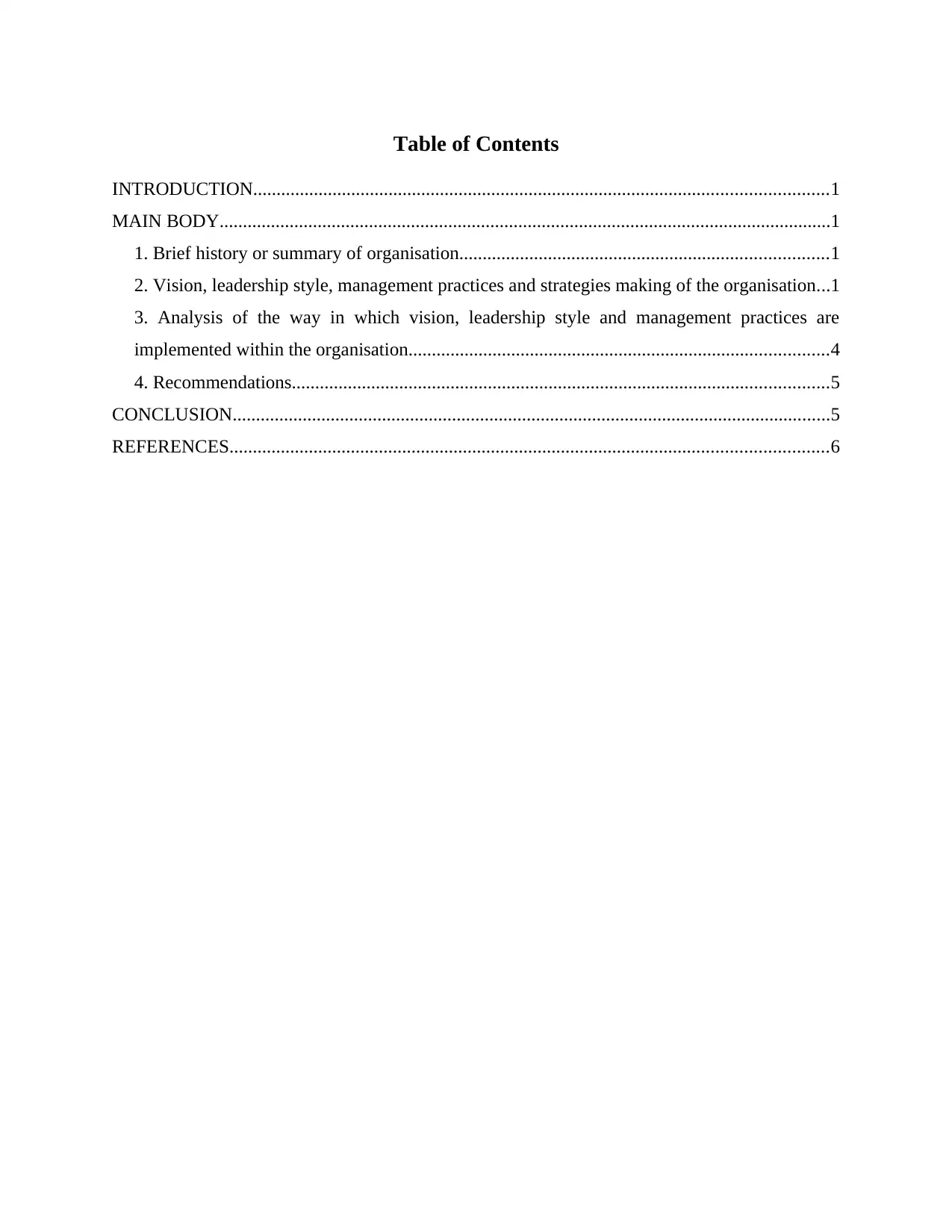
Table of Contents
INTRODUCTION...........................................................................................................................1
MAIN BODY...................................................................................................................................1
1. Brief history or summary of organisation...............................................................................1
2. Vision, leadership style, management practices and strategies making of the organisation...1
3. Analysis of the way in which vision, leadership style and management practices are
implemented within the organisation..........................................................................................4
4. Recommendations...................................................................................................................5
CONCLUSION................................................................................................................................5
REFERENCES................................................................................................................................6
INTRODUCTION...........................................................................................................................1
MAIN BODY...................................................................................................................................1
1. Brief history or summary of organisation...............................................................................1
2. Vision, leadership style, management practices and strategies making of the organisation...1
3. Analysis of the way in which vision, leadership style and management practices are
implemented within the organisation..........................................................................................4
4. Recommendations...................................................................................................................5
CONCLUSION................................................................................................................................5
REFERENCES................................................................................................................................6
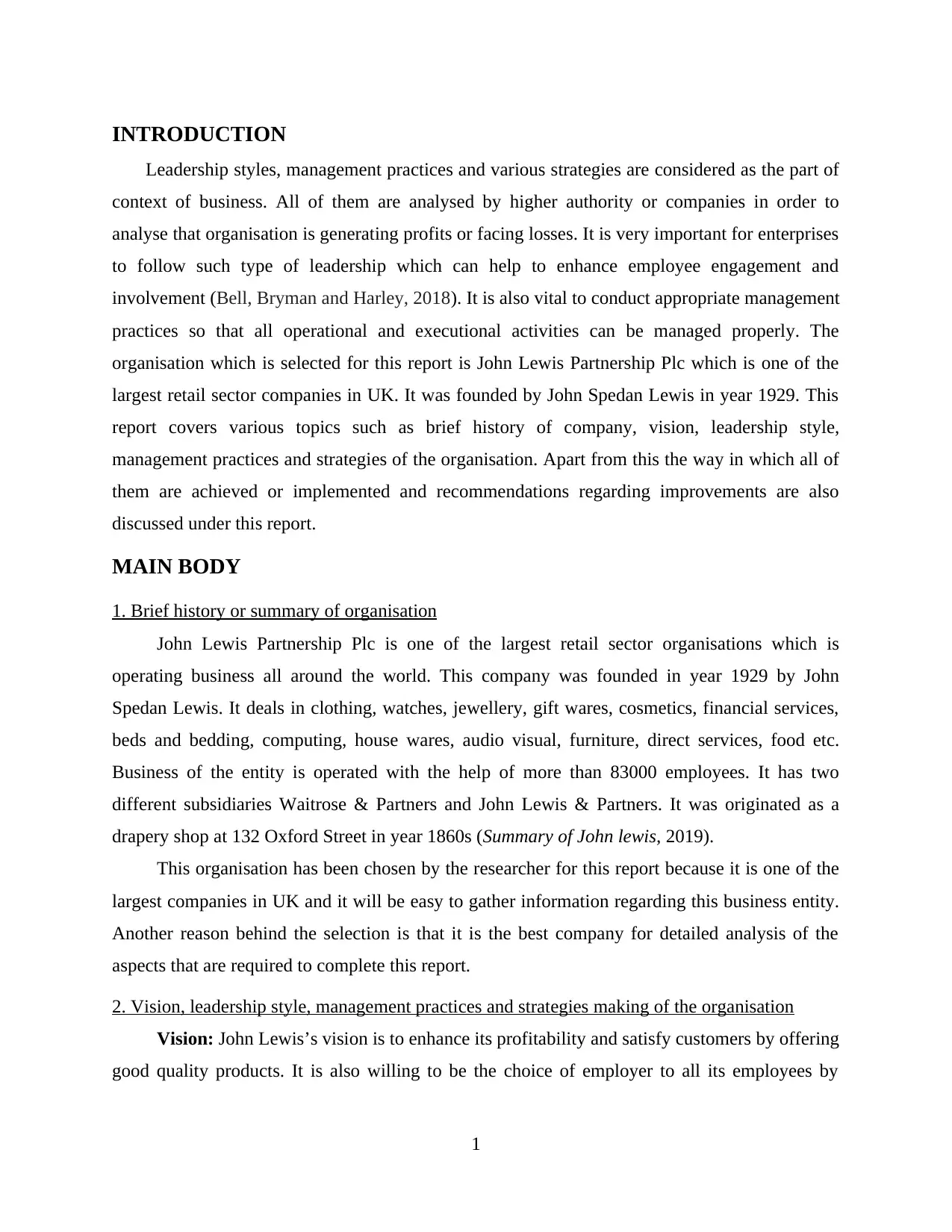
INTRODUCTION
Leadership styles, management practices and various strategies are considered as the part of
context of business. All of them are analysed by higher authority or companies in order to
analyse that organisation is generating profits or facing losses. It is very important for enterprises
to follow such type of leadership which can help to enhance employee engagement and
involvement (Bell, Bryman and Harley, 2018). It is also vital to conduct appropriate management
practices so that all operational and executional activities can be managed properly. The
organisation which is selected for this report is John Lewis Partnership Plc which is one of the
largest retail sector companies in UK. It was founded by John Spedan Lewis in year 1929. This
report covers various topics such as brief history of company, vision, leadership style,
management practices and strategies of the organisation. Apart from this the way in which all of
them are achieved or implemented and recommendations regarding improvements are also
discussed under this report.
MAIN BODY
1. Brief history or summary of organisation
John Lewis Partnership Plc is one of the largest retail sector organisations which is
operating business all around the world. This company was founded in year 1929 by John
Spedan Lewis. It deals in clothing, watches, jewellery, gift wares, cosmetics, financial services,
beds and bedding, computing, house wares, audio visual, furniture, direct services, food etc.
Business of the entity is operated with the help of more than 83000 employees. It has two
different subsidiaries Waitrose & Partners and John Lewis & Partners. It was originated as a
drapery shop at 132 Oxford Street in year 1860s (Summary of John lewis, 2019).
This organisation has been chosen by the researcher for this report because it is one of the
largest companies in UK and it will be easy to gather information regarding this business entity.
Another reason behind the selection is that it is the best company for detailed analysis of the
aspects that are required to complete this report.
2. Vision, leadership style, management practices and strategies making of the organisation
Vision: John Lewis’s vision is to enhance its profitability and satisfy customers by offering
good quality products. It is also willing to be the choice of employer to all its employees by
1
Leadership styles, management practices and various strategies are considered as the part of
context of business. All of them are analysed by higher authority or companies in order to
analyse that organisation is generating profits or facing losses. It is very important for enterprises
to follow such type of leadership which can help to enhance employee engagement and
involvement (Bell, Bryman and Harley, 2018). It is also vital to conduct appropriate management
practices so that all operational and executional activities can be managed properly. The
organisation which is selected for this report is John Lewis Partnership Plc which is one of the
largest retail sector companies in UK. It was founded by John Spedan Lewis in year 1929. This
report covers various topics such as brief history of company, vision, leadership style,
management practices and strategies of the organisation. Apart from this the way in which all of
them are achieved or implemented and recommendations regarding improvements are also
discussed under this report.
MAIN BODY
1. Brief history or summary of organisation
John Lewis Partnership Plc is one of the largest retail sector organisations which is
operating business all around the world. This company was founded in year 1929 by John
Spedan Lewis. It deals in clothing, watches, jewellery, gift wares, cosmetics, financial services,
beds and bedding, computing, house wares, audio visual, furniture, direct services, food etc.
Business of the entity is operated with the help of more than 83000 employees. It has two
different subsidiaries Waitrose & Partners and John Lewis & Partners. It was originated as a
drapery shop at 132 Oxford Street in year 1860s (Summary of John lewis, 2019).
This organisation has been chosen by the researcher for this report because it is one of the
largest companies in UK and it will be easy to gather information regarding this business entity.
Another reason behind the selection is that it is the best company for detailed analysis of the
aspects that are required to complete this report.
2. Vision, leadership style, management practices and strategies making of the organisation
Vision: John Lewis’s vision is to enhance its profitability and satisfy customers by offering
good quality products. It is also willing to be the choice of employer to all its employees by
1
⊘ This is a preview!⊘
Do you want full access?
Subscribe today to unlock all pages.

Trusted by 1+ million students worldwide
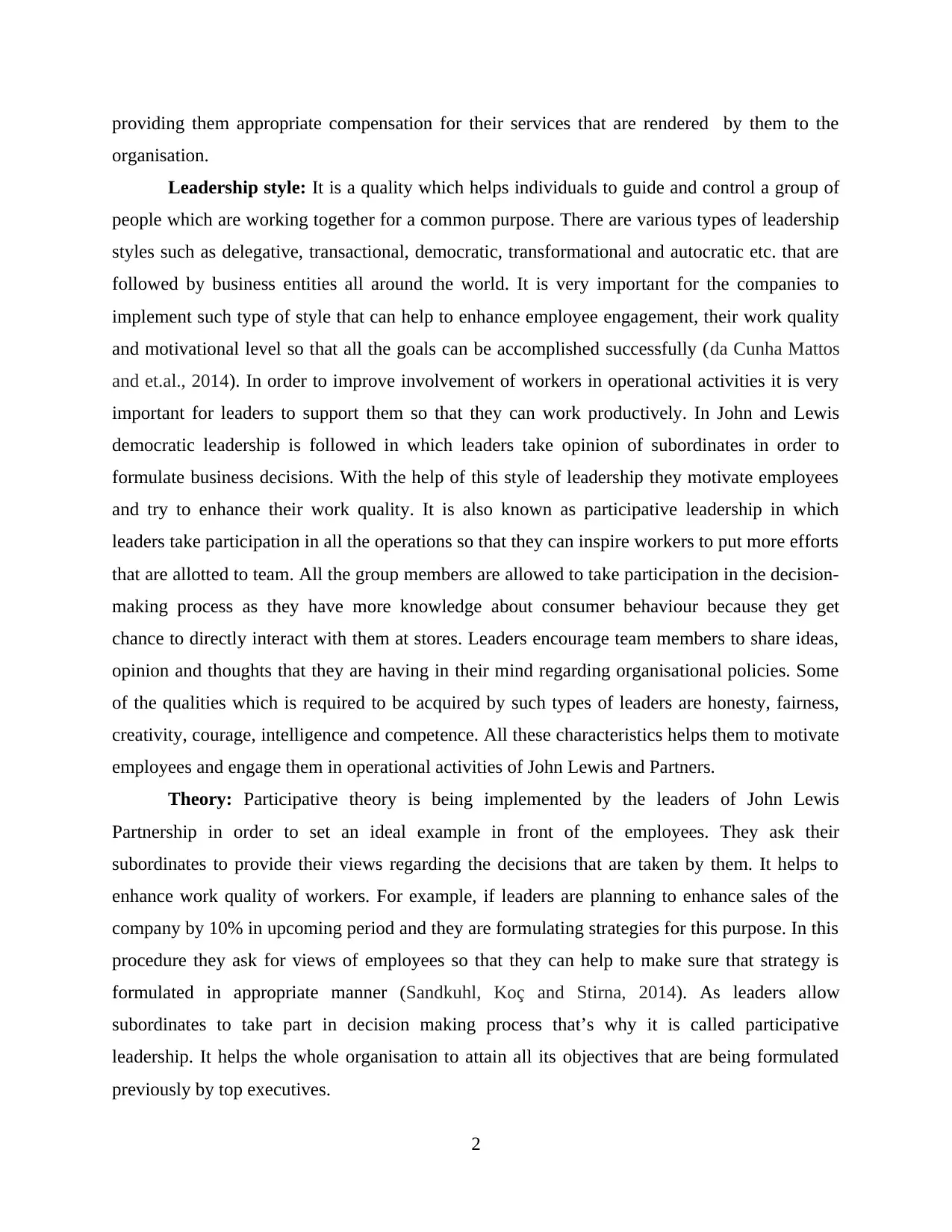
providing them appropriate compensation for their services that are rendered by them to the
organisation.
Leadership style: It is a quality which helps individuals to guide and control a group of
people which are working together for a common purpose. There are various types of leadership
styles such as delegative, transactional, democratic, transformational and autocratic etc. that are
followed by business entities all around the world. It is very important for the companies to
implement such type of style that can help to enhance employee engagement, their work quality
and motivational level so that all the goals can be accomplished successfully (da Cunha Mattos
and et.al., 2014). In order to improve involvement of workers in operational activities it is very
important for leaders to support them so that they can work productively. In John and Lewis
democratic leadership is followed in which leaders take opinion of subordinates in order to
formulate business decisions. With the help of this style of leadership they motivate employees
and try to enhance their work quality. It is also known as participative leadership in which
leaders take participation in all the operations so that they can inspire workers to put more efforts
that are allotted to team. All the group members are allowed to take participation in the decision-
making process as they have more knowledge about consumer behaviour because they get
chance to directly interact with them at stores. Leaders encourage team members to share ideas,
opinion and thoughts that they are having in their mind regarding organisational policies. Some
of the qualities which is required to be acquired by such types of leaders are honesty, fairness,
creativity, courage, intelligence and competence. All these characteristics helps them to motivate
employees and engage them in operational activities of John Lewis and Partners.
Theory: Participative theory is being implemented by the leaders of John Lewis
Partnership in order to set an ideal example in front of the employees. They ask their
subordinates to provide their views regarding the decisions that are taken by them. It helps to
enhance work quality of workers. For example, if leaders are planning to enhance sales of the
company by 10% in upcoming period and they are formulating strategies for this purpose. In this
procedure they ask for views of employees so that they can help to make sure that strategy is
formulated in appropriate manner (Sandkuhl, Koç and Stirna, 2014). As leaders allow
subordinates to take part in decision making process that’s why it is called participative
leadership. It helps the whole organisation to attain all its objectives that are being formulated
previously by top executives.
2
organisation.
Leadership style: It is a quality which helps individuals to guide and control a group of
people which are working together for a common purpose. There are various types of leadership
styles such as delegative, transactional, democratic, transformational and autocratic etc. that are
followed by business entities all around the world. It is very important for the companies to
implement such type of style that can help to enhance employee engagement, their work quality
and motivational level so that all the goals can be accomplished successfully (da Cunha Mattos
and et.al., 2014). In order to improve involvement of workers in operational activities it is very
important for leaders to support them so that they can work productively. In John and Lewis
democratic leadership is followed in which leaders take opinion of subordinates in order to
formulate business decisions. With the help of this style of leadership they motivate employees
and try to enhance their work quality. It is also known as participative leadership in which
leaders take participation in all the operations so that they can inspire workers to put more efforts
that are allotted to team. All the group members are allowed to take participation in the decision-
making process as they have more knowledge about consumer behaviour because they get
chance to directly interact with them at stores. Leaders encourage team members to share ideas,
opinion and thoughts that they are having in their mind regarding organisational policies. Some
of the qualities which is required to be acquired by such types of leaders are honesty, fairness,
creativity, courage, intelligence and competence. All these characteristics helps them to motivate
employees and engage them in operational activities of John Lewis and Partners.
Theory: Participative theory is being implemented by the leaders of John Lewis
Partnership in order to set an ideal example in front of the employees. They ask their
subordinates to provide their views regarding the decisions that are taken by them. It helps to
enhance work quality of workers. For example, if leaders are planning to enhance sales of the
company by 10% in upcoming period and they are formulating strategies for this purpose. In this
procedure they ask for views of employees so that they can help to make sure that strategy is
formulated in appropriate manner (Sandkuhl, Koç and Stirna, 2014). As leaders allow
subordinates to take part in decision making process that’s why it is called participative
leadership. It helps the whole organisation to attain all its objectives that are being formulated
previously by top executives.
2
Paraphrase This Document
Need a fresh take? Get an instant paraphrase of this document with our AI Paraphraser
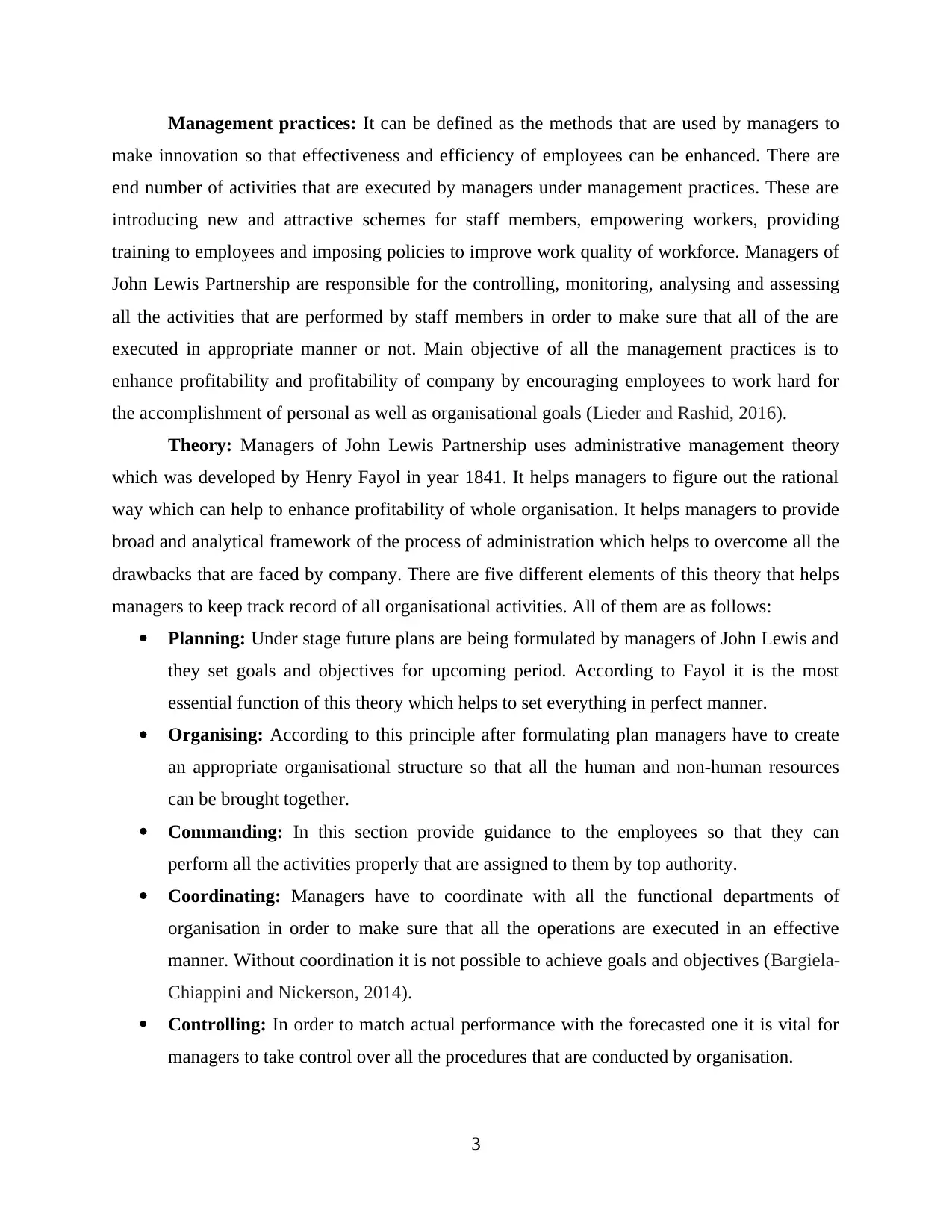
Management practices: It can be defined as the methods that are used by managers to
make innovation so that effectiveness and efficiency of employees can be enhanced. There are
end number of activities that are executed by managers under management practices. These are
introducing new and attractive schemes for staff members, empowering workers, providing
training to employees and imposing policies to improve work quality of workforce. Managers of
John Lewis Partnership are responsible for the controlling, monitoring, analysing and assessing
all the activities that are performed by staff members in order to make sure that all of the are
executed in appropriate manner or not. Main objective of all the management practices is to
enhance profitability and profitability of company by encouraging employees to work hard for
the accomplishment of personal as well as organisational goals (Lieder and Rashid, 2016).
Theory: Managers of John Lewis Partnership uses administrative management theory
which was developed by Henry Fayol in year 1841. It helps managers to figure out the rational
way which can help to enhance profitability of whole organisation. It helps managers to provide
broad and analytical framework of the process of administration which helps to overcome all the
drawbacks that are faced by company. There are five different elements of this theory that helps
managers to keep track record of all organisational activities. All of them are as follows:
Planning: Under stage future plans are being formulated by managers of John Lewis and
they set goals and objectives for upcoming period. According to Fayol it is the most
essential function of this theory which helps to set everything in perfect manner.
Organising: According to this principle after formulating plan managers have to create
an appropriate organisational structure so that all the human and non-human resources
can be brought together.
Commanding: In this section provide guidance to the employees so that they can
perform all the activities properly that are assigned to them by top authority.
Coordinating: Managers have to coordinate with all the functional departments of
organisation in order to make sure that all the operations are executed in an effective
manner. Without coordination it is not possible to achieve goals and objectives (Bargiela-
Chiappini and Nickerson, 2014).
Controlling: In order to match actual performance with the forecasted one it is vital for
managers to take control over all the procedures that are conducted by organisation.
3
make innovation so that effectiveness and efficiency of employees can be enhanced. There are
end number of activities that are executed by managers under management practices. These are
introducing new and attractive schemes for staff members, empowering workers, providing
training to employees and imposing policies to improve work quality of workforce. Managers of
John Lewis Partnership are responsible for the controlling, monitoring, analysing and assessing
all the activities that are performed by staff members in order to make sure that all of the are
executed in appropriate manner or not. Main objective of all the management practices is to
enhance profitability and profitability of company by encouraging employees to work hard for
the accomplishment of personal as well as organisational goals (Lieder and Rashid, 2016).
Theory: Managers of John Lewis Partnership uses administrative management theory
which was developed by Henry Fayol in year 1841. It helps managers to figure out the rational
way which can help to enhance profitability of whole organisation. It helps managers to provide
broad and analytical framework of the process of administration which helps to overcome all the
drawbacks that are faced by company. There are five different elements of this theory that helps
managers to keep track record of all organisational activities. All of them are as follows:
Planning: Under stage future plans are being formulated by managers of John Lewis and
they set goals and objectives for upcoming period. According to Fayol it is the most
essential function of this theory which helps to set everything in perfect manner.
Organising: According to this principle after formulating plan managers have to create
an appropriate organisational structure so that all the human and non-human resources
can be brought together.
Commanding: In this section provide guidance to the employees so that they can
perform all the activities properly that are assigned to them by top authority.
Coordinating: Managers have to coordinate with all the functional departments of
organisation in order to make sure that all the operations are executed in an effective
manner. Without coordination it is not possible to achieve goals and objectives (Bargiela-
Chiappini and Nickerson, 2014).
Controlling: In order to match actual performance with the forecasted one it is vital for
managers to take control over all the procedures that are conducted by organisation.
3
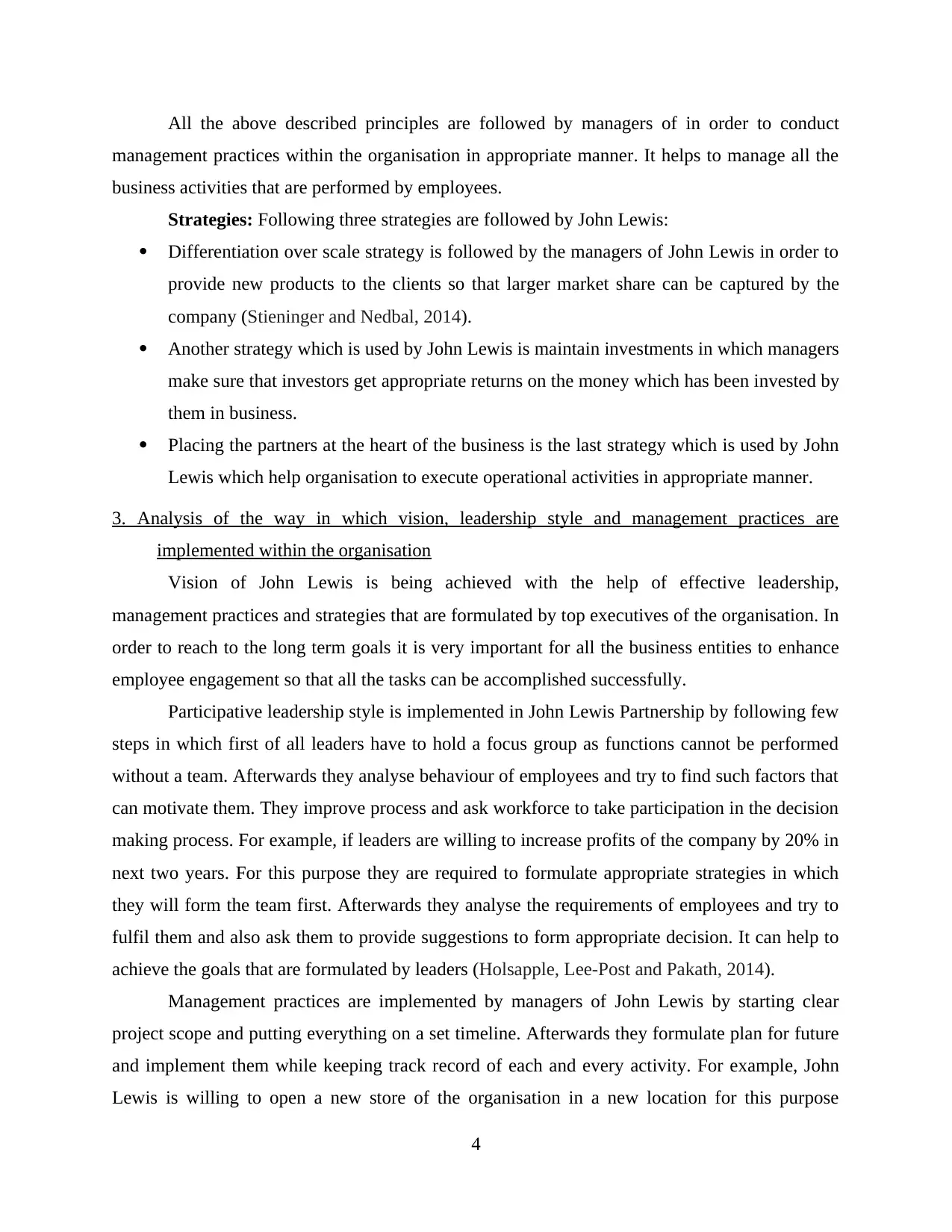
All the above described principles are followed by managers of in order to conduct
management practices within the organisation in appropriate manner. It helps to manage all the
business activities that are performed by employees.
Strategies: Following three strategies are followed by John Lewis:
Differentiation over scale strategy is followed by the managers of John Lewis in order to
provide new products to the clients so that larger market share can be captured by the
company (Stieninger and Nedbal, 2014).
Another strategy which is used by John Lewis is maintain investments in which managers
make sure that investors get appropriate returns on the money which has been invested by
them in business.
Placing the partners at the heart of the business is the last strategy which is used by John
Lewis which help organisation to execute operational activities in appropriate manner.
3. Analysis of the way in which vision, leadership style and management practices are
implemented within the organisation
Vision of John Lewis is being achieved with the help of effective leadership,
management practices and strategies that are formulated by top executives of the organisation. In
order to reach to the long term goals it is very important for all the business entities to enhance
employee engagement so that all the tasks can be accomplished successfully.
Participative leadership style is implemented in John Lewis Partnership by following few
steps in which first of all leaders have to hold a focus group as functions cannot be performed
without a team. Afterwards they analyse behaviour of employees and try to find such factors that
can motivate them. They improve process and ask workforce to take participation in the decision
making process. For example, if leaders are willing to increase profits of the company by 20% in
next two years. For this purpose they are required to formulate appropriate strategies in which
they will form the team first. Afterwards they analyse the requirements of employees and try to
fulfil them and also ask them to provide suggestions to form appropriate decision. It can help to
achieve the goals that are formulated by leaders (Holsapple, Lee-Post and Pakath, 2014).
Management practices are implemented by managers of John Lewis by starting clear
project scope and putting everything on a set timeline. Afterwards they formulate plan for future
and implement them while keeping track record of each and every activity. For example, John
Lewis is willing to open a new store of the organisation in a new location for this purpose
4
management practices within the organisation in appropriate manner. It helps to manage all the
business activities that are performed by employees.
Strategies: Following three strategies are followed by John Lewis:
Differentiation over scale strategy is followed by the managers of John Lewis in order to
provide new products to the clients so that larger market share can be captured by the
company (Stieninger and Nedbal, 2014).
Another strategy which is used by John Lewis is maintain investments in which managers
make sure that investors get appropriate returns on the money which has been invested by
them in business.
Placing the partners at the heart of the business is the last strategy which is used by John
Lewis which help organisation to execute operational activities in appropriate manner.
3. Analysis of the way in which vision, leadership style and management practices are
implemented within the organisation
Vision of John Lewis is being achieved with the help of effective leadership,
management practices and strategies that are formulated by top executives of the organisation. In
order to reach to the long term goals it is very important for all the business entities to enhance
employee engagement so that all the tasks can be accomplished successfully.
Participative leadership style is implemented in John Lewis Partnership by following few
steps in which first of all leaders have to hold a focus group as functions cannot be performed
without a team. Afterwards they analyse behaviour of employees and try to find such factors that
can motivate them. They improve process and ask workforce to take participation in the decision
making process. For example, if leaders are willing to increase profits of the company by 20% in
next two years. For this purpose they are required to formulate appropriate strategies in which
they will form the team first. Afterwards they analyse the requirements of employees and try to
fulfil them and also ask them to provide suggestions to form appropriate decision. It can help to
achieve the goals that are formulated by leaders (Holsapple, Lee-Post and Pakath, 2014).
Management practices are implemented by managers of John Lewis by starting clear
project scope and putting everything on a set timeline. Afterwards they formulate plan for future
and implement them while keeping track record of each and every activity. For example, John
Lewis is willing to open a new store of the organisation in a new location for this purpose
4
⊘ This is a preview!⊘
Do you want full access?
Subscribe today to unlock all pages.

Trusted by 1+ million students worldwide
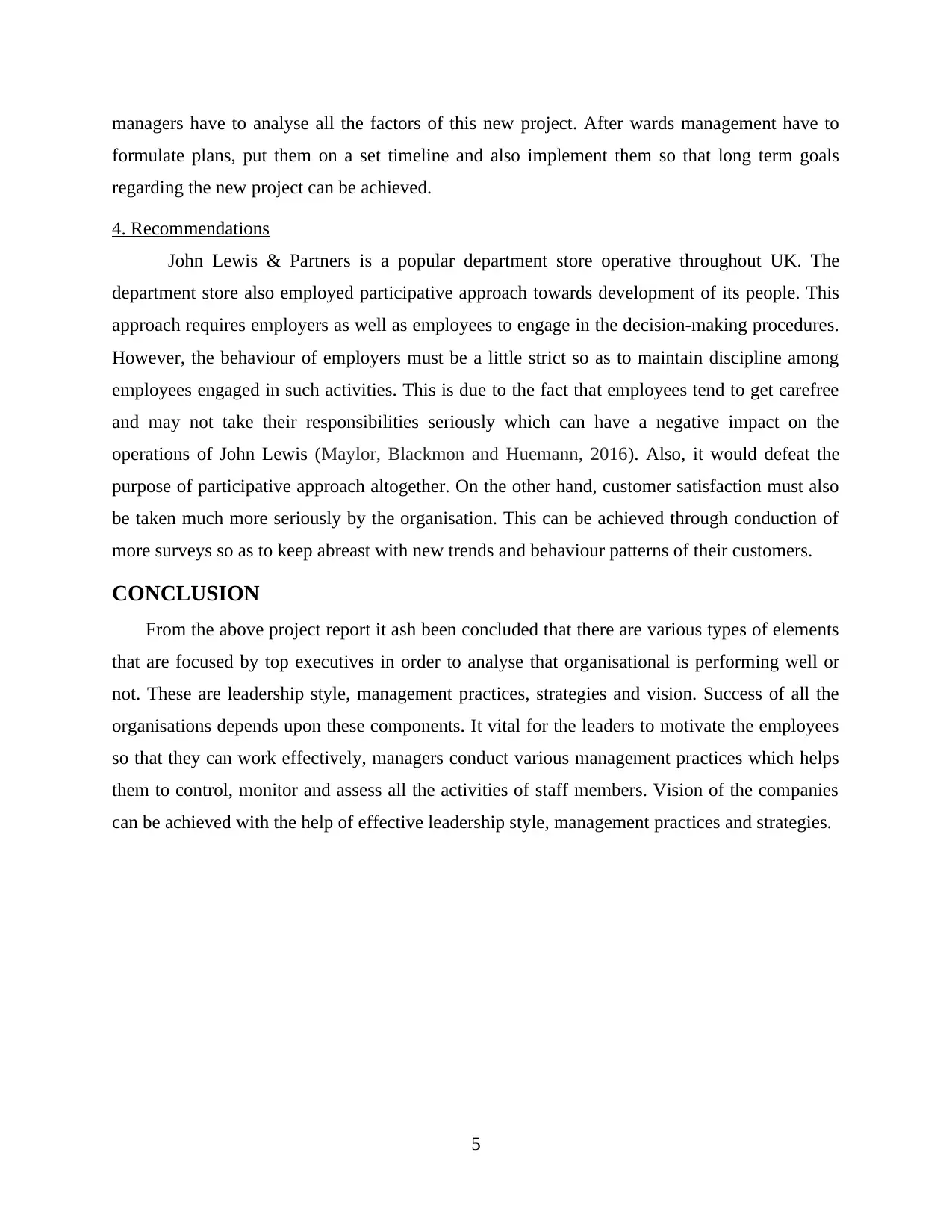
managers have to analyse all the factors of this new project. After wards management have to
formulate plans, put them on a set timeline and also implement them so that long term goals
regarding the new project can be achieved.
4. Recommendations
John Lewis & Partners is a popular department store operative throughout UK. The
department store also employed participative approach towards development of its people. This
approach requires employers as well as employees to engage in the decision-making procedures.
However, the behaviour of employers must be a little strict so as to maintain discipline among
employees engaged in such activities. This is due to the fact that employees tend to get carefree
and may not take their responsibilities seriously which can have a negative impact on the
operations of John Lewis (Maylor, Blackmon and Huemann, 2016). Also, it would defeat the
purpose of participative approach altogether. On the other hand, customer satisfaction must also
be taken much more seriously by the organisation. This can be achieved through conduction of
more surveys so as to keep abreast with new trends and behaviour patterns of their customers.
CONCLUSION
From the above project report it ash been concluded that there are various types of elements
that are focused by top executives in order to analyse that organisational is performing well or
not. These are leadership style, management practices, strategies and vision. Success of all the
organisations depends upon these components. It vital for the leaders to motivate the employees
so that they can work effectively, managers conduct various management practices which helps
them to control, monitor and assess all the activities of staff members. Vision of the companies
can be achieved with the help of effective leadership style, management practices and strategies.
5
formulate plans, put them on a set timeline and also implement them so that long term goals
regarding the new project can be achieved.
4. Recommendations
John Lewis & Partners is a popular department store operative throughout UK. The
department store also employed participative approach towards development of its people. This
approach requires employers as well as employees to engage in the decision-making procedures.
However, the behaviour of employers must be a little strict so as to maintain discipline among
employees engaged in such activities. This is due to the fact that employees tend to get carefree
and may not take their responsibilities seriously which can have a negative impact on the
operations of John Lewis (Maylor, Blackmon and Huemann, 2016). Also, it would defeat the
purpose of participative approach altogether. On the other hand, customer satisfaction must also
be taken much more seriously by the organisation. This can be achieved through conduction of
more surveys so as to keep abreast with new trends and behaviour patterns of their customers.
CONCLUSION
From the above project report it ash been concluded that there are various types of elements
that are focused by top executives in order to analyse that organisational is performing well or
not. These are leadership style, management practices, strategies and vision. Success of all the
organisations depends upon these components. It vital for the leaders to motivate the employees
so that they can work effectively, managers conduct various management practices which helps
them to control, monitor and assess all the activities of staff members. Vision of the companies
can be achieved with the help of effective leadership style, management practices and strategies.
5
Paraphrase This Document
Need a fresh take? Get an instant paraphrase of this document with our AI Paraphraser
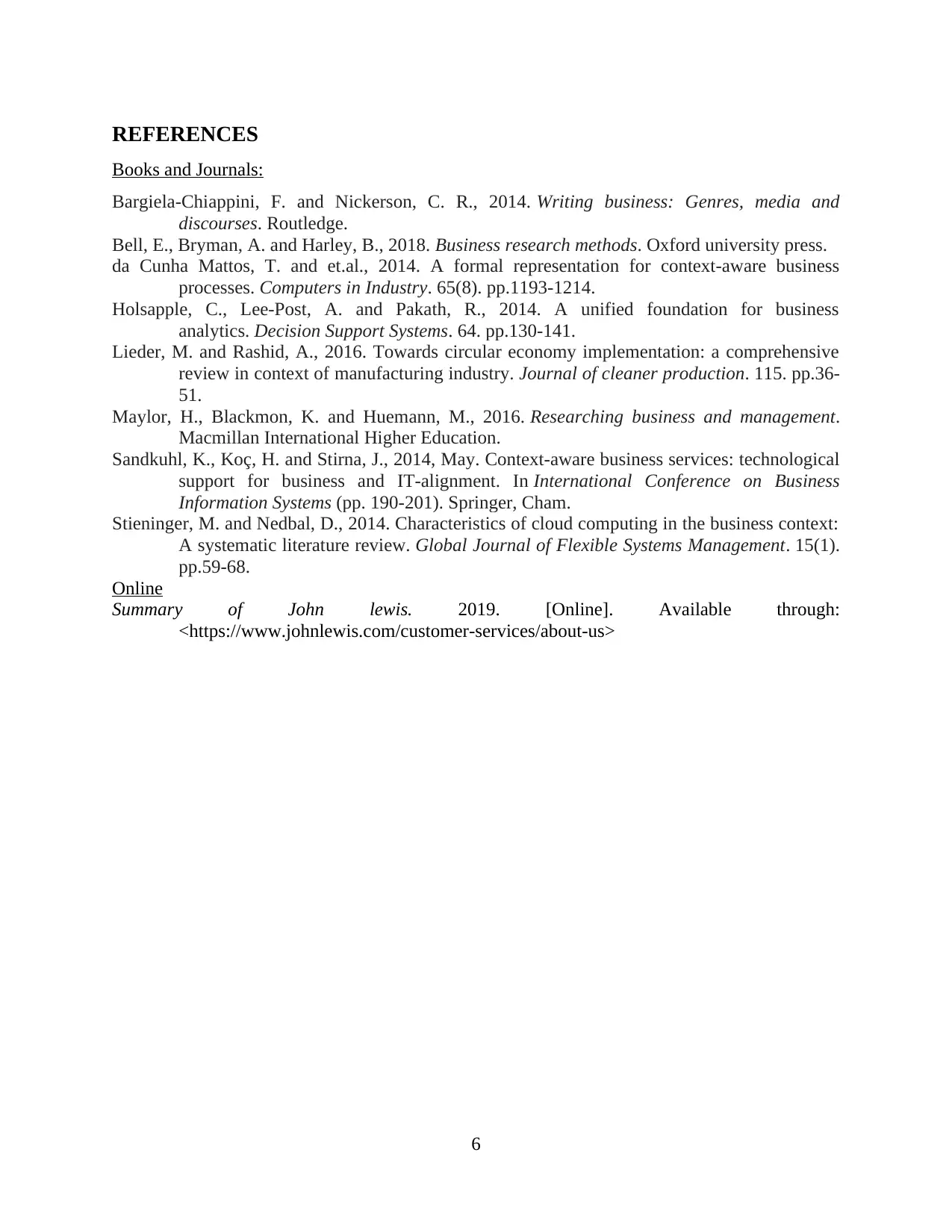
REFERENCES
Books and Journals:
Bargiela-Chiappini, F. and Nickerson, C. R., 2014. Writing business: Genres, media and
discourses. Routledge.
Bell, E., Bryman, A. and Harley, B., 2018. Business research methods. Oxford university press.
da Cunha Mattos, T. and et.al., 2014. A formal representation for context-aware business
processes. Computers in Industry. 65(8). pp.1193-1214.
Holsapple, C., Lee-Post, A. and Pakath, R., 2014. A unified foundation for business
analytics. Decision Support Systems. 64. pp.130-141.
Lieder, M. and Rashid, A., 2016. Towards circular economy implementation: a comprehensive
review in context of manufacturing industry. Journal of cleaner production. 115. pp.36-
51.
Maylor, H., Blackmon, K. and Huemann, M., 2016. Researching business and management.
Macmillan International Higher Education.
Sandkuhl, K., Koç, H. and Stirna, J., 2014, May. Context-aware business services: technological
support for business and IT-alignment. In International Conference on Business
Information Systems (pp. 190-201). Springer, Cham.
Stieninger, M. and Nedbal, D., 2014. Characteristics of cloud computing in the business context:
A systematic literature review. Global Journal of Flexible Systems Management. 15(1).
pp.59-68.
Online
Summary of John lewis. 2019. [Online]. Available through:
<https://www.johnlewis.com/customer-services/about-us>
6
Books and Journals:
Bargiela-Chiappini, F. and Nickerson, C. R., 2014. Writing business: Genres, media and
discourses. Routledge.
Bell, E., Bryman, A. and Harley, B., 2018. Business research methods. Oxford university press.
da Cunha Mattos, T. and et.al., 2014. A formal representation for context-aware business
processes. Computers in Industry. 65(8). pp.1193-1214.
Holsapple, C., Lee-Post, A. and Pakath, R., 2014. A unified foundation for business
analytics. Decision Support Systems. 64. pp.130-141.
Lieder, M. and Rashid, A., 2016. Towards circular economy implementation: a comprehensive
review in context of manufacturing industry. Journal of cleaner production. 115. pp.36-
51.
Maylor, H., Blackmon, K. and Huemann, M., 2016. Researching business and management.
Macmillan International Higher Education.
Sandkuhl, K., Koç, H. and Stirna, J., 2014, May. Context-aware business services: technological
support for business and IT-alignment. In International Conference on Business
Information Systems (pp. 190-201). Springer, Cham.
Stieninger, M. and Nedbal, D., 2014. Characteristics of cloud computing in the business context:
A systematic literature review. Global Journal of Flexible Systems Management. 15(1).
pp.59-68.
Online
Summary of John lewis. 2019. [Online]. Available through:
<https://www.johnlewis.com/customer-services/about-us>
6
1 out of 8
Related Documents
Your All-in-One AI-Powered Toolkit for Academic Success.
+13062052269
info@desklib.com
Available 24*7 on WhatsApp / Email
![[object Object]](/_next/static/media/star-bottom.7253800d.svg)
Unlock your academic potential
Copyright © 2020–2025 A2Z Services. All Rights Reserved. Developed and managed by ZUCOL.





